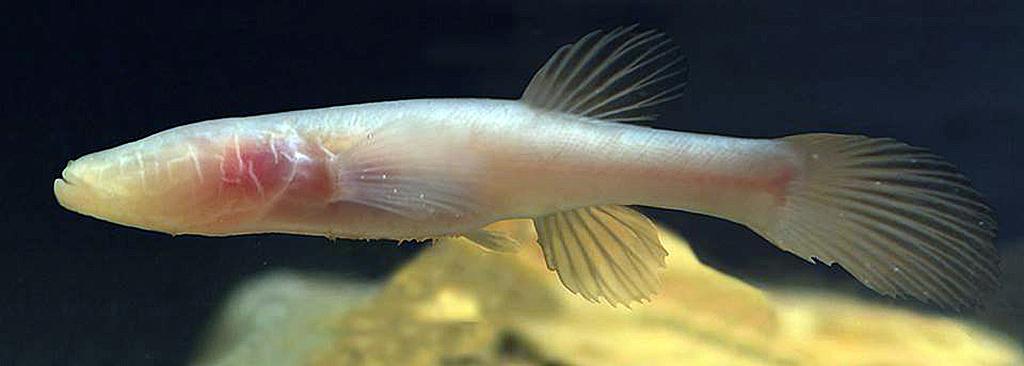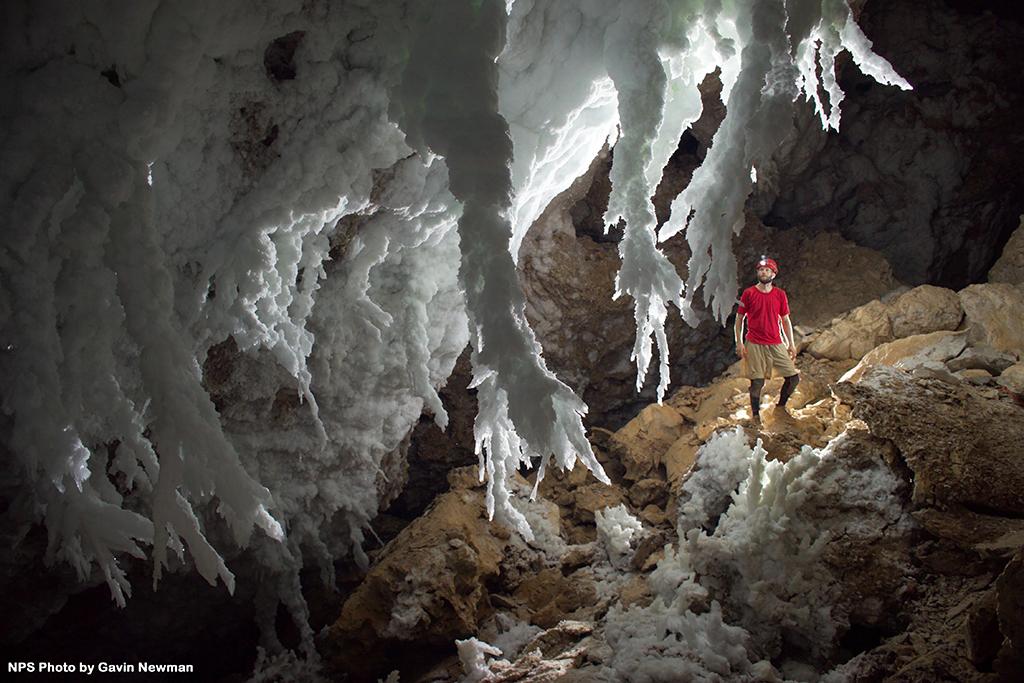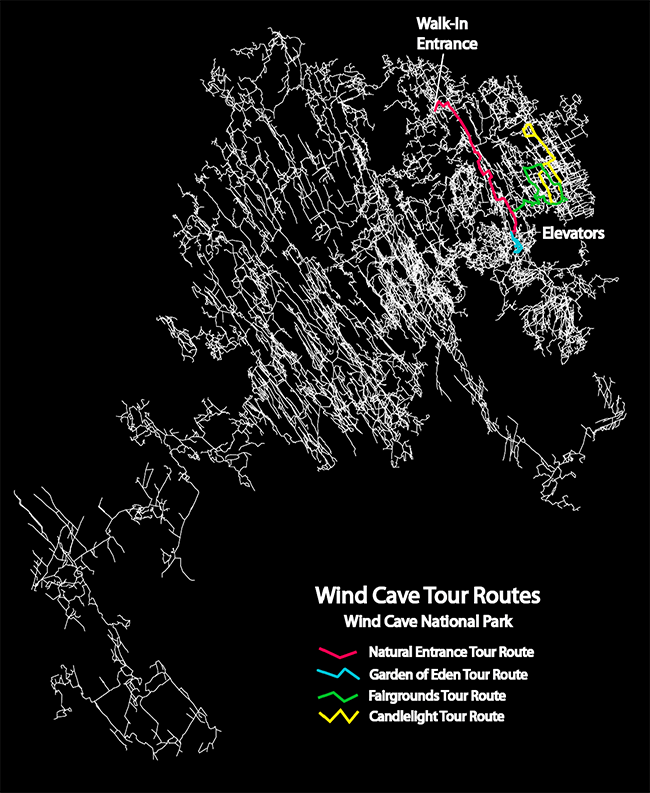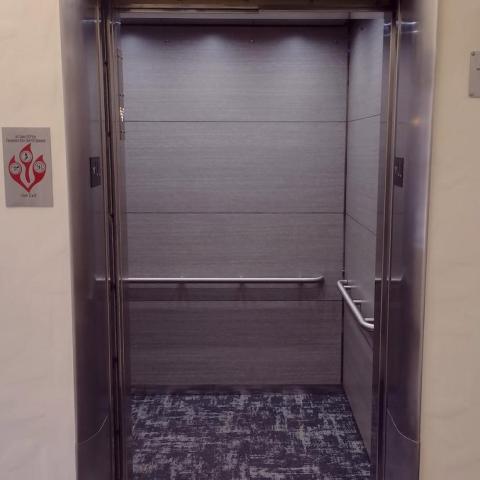
A historical photo of a ranger talking with tourists in front of the entrance to Jewel Cave, Jewel Cave National Monument / NPS file
There are quite a few cave-centric units within the National Park System. While these parks provide interesting landscapes both above and below ground, they really are all about the caves. After my visits to Wind Cave National Park and Jewel Cave National Monument, I thought it fitting there should be a quiz and trivia piece about the caves we have a chance to explore within the parks. Test your knowledge and find out how much you know.
1. Mammoth Cave in Kentucky is still the longest cave system not only in the United States, but in the world, with an astounding 426 miles (685.6 km). True or False: the second-longest cave in the United States is Wind Cave.
a) True
b) False

Historical graffiti at Gothic Avenue, Mammoth Cave National Park / NPS-Jackie Wheet
2. The National Park Service manages over ___ caves, with at least four extending for more than 135 miles.
a) 1,250
b) 2,355
c) 3,600
d) 4,700
3. According to the National Park Service’s website, there are ___ cave types.
a) Two
b) Four
c) Six
d) Eight

Looking from the inside out at Nāhuku (Thurston Lava Tube), Hawai'i Volcanoes National Park / Rebecca Latson
4. Lava flowing through a lava tube can be as hot as or hotter than ___ degrees.
a) 5,000 oF (2,760 oC)
b) 2,000 oF (1,090 oC)
c) 10,000 oF (5,538 oC)
d) 1,000 oF (538 oC)

An eyeless fish found in Mammoth Cave National Park / NPS file
5. True or False: Animals and insects specifically adapted to live in a cave’s ecosystem are known as troglodytes.
a) True
b) False
6. Jewel Cave National Monument in South Dakota has one of the largest colonies of hibernating Townsend’s big-eared bats. This cave, as well as other caves used by hibernating bats, is considered a ___.
a) Sleep chamber
b) Hibernaculum
c) Roost
d) Winter shelter
7. Let’s stick with bats a little bit longer. Carlsbad Caverns National Park in New Mexico hosts ___ different bat species.
a) 9
b) 13
c) 17
d) 21

A large room in Crystal Cave, Sequoia and Kings Canyon National Parks / NPS-Alison Taggart-Barone
8. Crystal Cave, located at Sequoia National Park in California, is an example of a ___ cavern.
a) Marble
b) Dolomite
c) Schist
d) Limestone

The Chandelier Ballroom of Lechuguilla Cave, Carlsbad Caverns National Park / NPS-Gavin Newman
9. True or False: Lechuguilla Cave, located in Carlsbad Caverns National Park, is the longest limestone cave in the U.S.
a) True
b) False

Stopping for a discussion of the Inscription Room in Lehman Caves, Great Basin National Park / Rebecca Latson
10. There are ___ known caves located at Great Basin National Park in Nevada.
a) 10
b) 20
c) 30
d) 40
Trivia

Cave system layout with outlined tours at Wind Cave National Park / NPmaps.com
We tend to think of Wind Cave covering a wide swath of landscape below ground, and that no matter where we walk within the park, we are treading above a cave passage deep beneath. That’s not really the case. Instead, imagine you are a drone hovering over the surface landscape of Wind Cave (btw, drones are prohibited in the park) and peering with x-ray vision into the subterranean depths. You’d discover the cave system would cover a little over one square mile of surface area, most of it located beneath the park’s visitor center and administrative/housing buildings. How can this be, when the Wind Cave system extends (as of today) an astounding 167 miles? Picture a bowl of spaghetti. The bowl is only so wide in diameter, but deep enough that you can squeeze in quite a few noodles from bowl rim to bowl bottom. It’s the same with the cave passages in this national park. Maps may show a spread-out version of the cave system, but in truth, those “noodle” cave passages extend downward into that “spaghetti bowl” rather than outward.

Saltpetre vats in the Rotunda of Mammoth Cave National Park / NPS-David Kem
Caves have been explored, exploited, and even mined. According to the National Park Service, “Thousands of years of occupation by bats who deposited guano in the soil of Mammoth Cave and other area caves made the cave dirt rich with a compound called calcium nitrate. Calcium nitrate is a mineral that can be mixed with other high potassium materials to create potassium nitrate, or saltpetre, as it is more commonly known. Saltpetre is a principal ingredient in black gunpowder.” To read more about saltpetre mining at Mammoth Cave, click here.

Frank and Albert Michaud, Jewel Cave National Monument / NPS file
According to the National Park Service, “The earliest written account of Jewel Cave is a mining claim filed by Frank and Albert Michaud in 1900. The brothers described the entrance as a hole that was too small for human entry, with a blast of cold air coming out. After subsequent enlargement with hand tools and dynamite, they entered the cave with Charles Bush, a friend of the family, discovering crawlways and low-ceilinged rooms coated with beautiful calcite crystals that sparkled like ‘jewels’ in their lantern light.”
“The Michauds filed the ‘Jewel Tunnel’ mining claim in Custer on October 31, 1900. Although calcite crystals have little commercial value, the mining claim allowed the Michauds and Bush a relatively fast and easy way to control access to this natural wonder. It is theorized that they had always planned to use the cave for tourism, possibly inspired by Wind Cave National Park, established in 1903. The Michauds did mine and sell some of the crystals to prove that it was an active mine. Most of the crystals were sold to a priest in Iowa who was building a church out of crystals from all over the world.” To read more about the history of Jewel Cave, click here.
Quiz Answers
1b False
The second-longest cave in the United States is Jewel Cave, with 219.8 miles (353.69 km) mapped (maybe even more by the time this quiz is published). The third-longest cave in the U.S. is Wind Cave (167 miles / 268.76 km).
2d
The National Park Service manages over 4,700 caves with at least four of these that extend for more than 135 miles and are so complex that the casual visitor would be lost among the hundreds of passages to choose from. This also includes karst, a type of landform where sinkholes, sinking streams, and springs are considered normal features and are indicative of the relationship found between the surface and the underground. Click here to learn more about these landscapes beneath the parks.
3c
According to the National Park Service’s website, there are six cave types: ice caves, karst landscapes, solution caves, lava tubes, sea/littoral caves, and talus caves.
4b
Lava flowing through a lava tube can be as hot as or hotter than 2,000 oF (1,090 oC). To learn more about lava tubes, click here.
5b
While humans are considered animals and have lived in caves in the prehistoric past (which makes them troglodytes) the correct term for an animal or insect specifically adapted to live in a cave’s ecosystem is troglobite.
6b
While all four of the answers could ostensibly be used to describe the cave(s) in which bats hibernate during the winter, the correct term is hibernaculum, which, according to merriam-webster.com, is “a shelter occupied during the winter by a dormant animal (such as an insect, snake, bat, or marmot).”
7c
Carlsbad Caverns National Park hosts 17 different bat species, including the large colony of Brazilian free-tailed bats “which wow visitors every evening from spring through fall with its spectacular outflights.”
8a
Crystal Cave is an example of a marble cavern. According to the National Park Service, “The marble represents an old limestone changed to a beautiful crystalline form by the intense heat and pressure it experienced during mountain making movements in the earth's crust many millions of years ago. The limestone had its origin in the limy ooze deposited on the bottom of an ancient sea that covered this area in still more remote times. Since no fossils have been found in the marble, its geologic age is unknown.” To read more about Crystal Cave (currently closed due to damage from the 2021 KNP Complex wildfire and subsequent extreme winter weather in 2023), click here.
9b False
According to the National Park Service, “Lechuguilla is one of the ten longest caves in the world (one of the four longest in the United States) and the second deepest limestone cave in the country.” The deepest limestone cave in the U.S. is Tears of the Turtle Cave in Montana, with a recorded depth of 2,052 feet (625 meters) as of August 2022. Lechuguilla Cave is 1,604 feet (489 m) deep, and almost 150 miles (242.0 km) long, as of July 2019. To learn more about Lechuguilla Cave, click here. P.S. Lechuguilla Cave is not open to the public, in case you were wondering.
10d
According to the National Park Service, “Great Basin National Park contains 40 known caves.” Lehman Caves is probably the best-known cave system and most easily accessible. To read more about the origin of Lehman Caves, click here. To learn about the tours offered, click here.




 Support Essential Coverage of Essential Places
Support Essential Coverage of Essential Places






